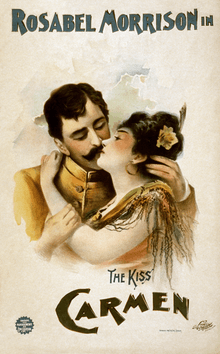Eidoloscope
The Eidoloscope was an early motion picture system created by Eugene Augustin Lauste, Woodville Latham and his two sons through their business, the Lambda Company, in New York City in 1894 and 1895. The Eidoloscope was demonstrated for members of the press on April 21, 1895, and opened to the paying public on Broadway on May 20.[1][2][3]
History
Originally called the Pantoptikon (also spelled 'Panoptikon'), it is perhaps the first widescreen film format, with an aspect ratio of 1.85. It had a film gauge of 51 mm and an aperture of 37 mm by 20 mm. It was instrumental in the history of film in that it created what became known as the "Latham loop", which are two loops of film, one on each side of the intermittent movement, which act as a buffer between continuously moving sprockets and the jerky motion of the intermittent movement. This relieved strain on the filmstrip and so enabled the shooting and projection of much longer motion pictures than had previously been possible.
Early beginnings
Woodville Latham, one of the creators of the Eidoloscope, was originally a chemistry professor.[6] Woodville's sons were in the business of showing boxing matches and would frequently hear complaints from patrons about how someone should make a machine that projects film on a screen. That way, more people could view the film at the same time, unlike the kinetoscope. It was a much more efficient method of exhibition that would reduce start-up costs, since each parlor would need only one machine instead of six. W.K.L Dickson, an employee of Edison's at the same time, joined the Latham's and their project to help raise finances and the knowledge of how to move forward in the business.[7] The Eidoloscope was engineered mainly by Lauste, who also assisted with the design of the Latham loop. (Later, Dickson would credit Lauste with the loop's invention)[2].
The Lathams named their company after the Greek letter for "L", lambda.[8] The features that the Lathams produced were of poor quality and lacked the tilts and pans that other features were beginning to utilize.[9] Unfortunately, the company did not last long since disputes over the copyrights from The Eidoloscope Company shareholders brought the Lathams' demise in 1896.[10]
See also
- List of film formats
References
- Streible, Dan. Fight Pictures: A History of Boxing and Early Cinema. University of California Press. p. 46. ISBN 9780520940581. Retrieved 16 May 2016.
- Domankiewicz, Peter (2020-05-20). "Happy 125th Birthday, Cinema! Part 1". William Friese-Greene & Me. Retrieved 2020-05-23.
- Domankiewicz, Peter (2020-05-20). "Happy 125th Birthday, Cinema! Part 2". William Friese-Greene & Me. Retrieved 2020-05-23.
- Waltz, Gwendolyn (2012). "'Half Real–Half Reel': Alternation Format Stage-and-Screen Hybrids". In Gaudreault, André; Dulac, Nicolas; Hidalgo, Santiago (eds.). A Companion to Early Cinema. Wiley-Blackwell. p. 360. ISBN 978-1-118-29387-4.
- "Announcements". The Courier. Lincoln, Nebraska. January 23, 1897. Retrieved January 8, 2019.
- Musser, C., "Projecting Motion Pictures: Invention", Vol. 1. New York: Charles Scribner's Sons, 1990
- Musser, C., "Projecting Motion Pictures: Invention", Vol. 1. New York: Charles Scribner's Sons, 1990
- Musser, C., "Projecting Motion Pictures: Invention", Vol. 1. New York: Charles Scribner's Sons, 1990
- Musser, C. "Early Motion-Picture Companies." The Emergence of Cinema: The American Cinema to 1907. Charles Musser. Ed. Charles Harpole. Vol. 1. New York: Charles Scribner's Sons, 1990
- Musser, C. "Early Motion-Picture Companies." The Emergence of Cinema: The American Cinema to 1907. Charles Musser. Ed. Charles Harpole. Vol. 1. New York: Charles Scribner's Sons, 1990
"Early Motion-Picture Companies." The Emergence of Cinema: The American Cinema to 1907. Charles Musser. Ed. Charles Harpole. Vol. 1. New York: Charles Scribner's Sons, 1990. [133]-157. History of the American Cinema 1.
"Projecting Motion Pictures: Invention and Innovation." The Emergence of Cinema: The American Cinema to 1907. Charles Musser. Ed. Charles Harpole. Vol. 1. New York: Charles Scribner's Sons, 1990. [91]-105. History of the American Cinema 1.
